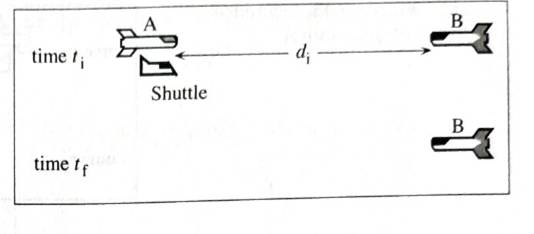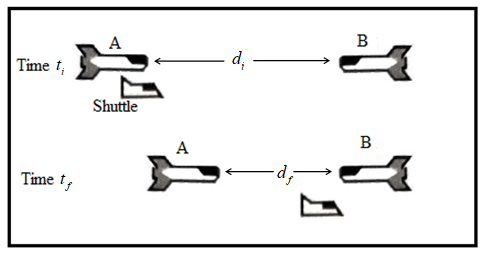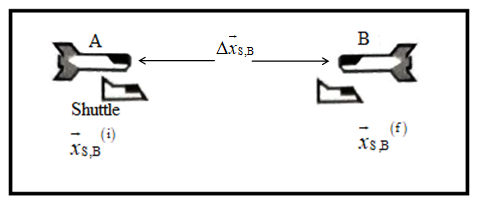
The second diagram at right shows the positions of spaceships A, B, and the shuttle at time
Sketch spaceship A and the shuttle at their positions at time
Explain how the diagram is consistent with the fact that in its own frame of reference, spaceship B is not moving.
Diagram for refrence frame of spaceship B

In the box at right, draw and label vectors for the following quantities:

•
•
•
Is the quantity
• a single instant in time or an interval of time? Explain.
• the distance between two objects or the distance traveled by a single object? Explain.
Describe how you could use
To Draw: Spaceship A and the shuttle at their positions at time
The vectors of the following quantities in frame of spaceship B
To Explain:Whether the diagram is consistent with the fact that in its own frame of reference spaceship B is not moving.
The use of
Answer to Problem 1aT
The diagram is consistent with the fact that in its own frame of reference spaceship B is not moving. The quantity
Explanation of Solution
Introduction:
Spaceship A and B are moving towards each other and spaceship A releases the shuttle at time
Spaceship A and the shuttle at their positions at time

The diagram is consistent with the fact that in its own frame of reference spaceship B is not moving as the body appears to be at rest with its own frame of reference.
Diagram having following quantities

Here,
The quantity
Here,
Conclusion:
Thus, the diagram is consistent with the fact that in its own frame of reference spaceship B is not moving. The quantity
Want to see more full solutions like this?
Chapter 1 Solutions
Tutorials in Introductory Physics
Additional Science Textbook Solutions
The Cosmic Perspective Fundamentals (2nd Edition)
College Physics: A Strategic Approach (3rd Edition)
Cosmic Perspective Fundamentals
Conceptual Physics (12th Edition)
The Cosmic Perspective
Essential University Physics: Volume 1 (3rd Edition)
- What is the velocity of an electron that has a momentum of 3.04×10-21?kg·m/s? Note that you must calculate the velocity to at least four digits to see the difference from c.arrow_forwardPart of the route of a roller coaster is as follows: b) Velocity in BVelocity in CMaximum compression (x) c)If the mass had been variable (m), how would your answers change? Note: just solve part carrow_forwardProblem 16.08 A person scuffing her feet on a wool rug on a dry day accumulates a net charge of -65 μC.arrow_forward
- A plane begins traveling at a(v) = ao – bv from a stationary position Part 1) determine the plane's v(t). Show in terms of ao and b. Part 2) determine the plane's distance traveled s(t). Show in terms of ao and b. Part 3) determine the plane's a(t). Show in terms of ao and b. Part 4) determine t = T* and s = S* when v reaches a determined takeoff value V*. Show T* and S* in terms of ao, bv and V*arrow_forward་ Part A A starship voyages to a distant planet 10 ly away. The explorers stay 4.0 yr, return at the same speed, and arrive back on earth 26 yr after they left. Assume that the time needed to accelerate and decelerate is negligible. What is the speed of the starship? Express your answer using two significant figures. = 0.91 Submit Previous Answers Part B Correct Important: If you use this answer in later parts, use the full unrounded value in your calculations. How much time has elapsed on the astronauts' chronometers? Express your answer using two significant figures. Η ΜΕ ΑΣΦ t = 52.4 Submit Previous Answers Request Answer ? × Incorrect; Try Again; 5 attempts remaining yearsarrow_forwardAnswer the following questions using the diagram from above. a) Which of the boxes in question 1 could be moving with a constant velocity? Justify your answer. b) Which of the boxes in question 1 could be at rest and remaining at rest? Justify your answer. c) Is it possible for the box in question 1b to be moving to the right? If so, is the box’s speed increasing, decreasing or staying the same? If not, explain why not. d) Is it possible for the box in question 1b to be moving to the left? If so, is the box’s speed increasing, decreasing or staying the same? If not, explain why not.arrow_forward
- Please answer part d super fastarrow_forwardI need only number 1 and 2 revise. The red color comment is written by my professor. *Please write your explain and tell me where I'm wrong and what did you change. Thank you 1. A rocket is moving at 1/4 c relative to Earth. At the center of this rocket, a light source suddenly flashes. To an observer at rest in the rocket a. the light pulse will reach the front of the rocket at the same instant that it reaches the back of the rocket. b. the light pulse will reach the front of the rocket before it reaches the back of the rocket. c. the light pulse will reach the front of the rocket after it reaches the back of the rocket. 2. A rocket is moving at 1/4 c relative to Earth. At the center of this rocket, a light source suddenly flashes. To an observer at rest on Earth a. the light pulse will reach the front of the rocket at the same instant that it reaches the back of the rocket. b. the light pulse will reach the front of the rocket before it reaches the back of the rocket. c. the light…arrow_forwardWrite the detailed solution. Please make sure that your handwritten is readable. Thank you. An older-model car accelerates from 0 to speed v in 15 s. A newer, more powerful sports car of the same mass accelerates from 0 to 3 v in the same time period. Assuming the energy coming from the engine appears only as kinetic energy of the cars, compare the power of the two cars.arrow_forward
- PROBLEM 1 Car B is travelling east with a speed of 30 m/s with an acceleration of 2 m/s², while car A is travelling north with a speed of 20 m/s. At t=0, the two cars are 2 km apart as shown in the figure below. a) Calculate the required acceleration of car A so that both cars collide at the origin of the shown coordinate frame b) At what time t does the collison take place ? 30 m/s 2km 20 m/s →X b)arrow_forwardView Policies Show Attempt History Current Attempt in Progress Your answer is partially correct. If d₁= 7î - 61 + 6k and d₂ 10î – 5ĵ + 2k, then what is (d ₁ + = Number i Save for Later 2459.958765 ·à₂). (d ₁ × 4d ₂)? Units This answer has no units Attempts: 1 of 5 used Submit Answerarrow_forwardA rocket cruises past a laboratory at 0.300 x 106 m/s in the positive r-direction just as a proton is launched with velocity (in the laboratory frame) Part A i = (1.69 x 10°% +1.69 × 10°3) m/s. What is the proton's speed in the laboratory frame? Express your answer with the appropriate units. HẢ ? Value = la Units Submit Request Answer Part B What is the angle from the y-axis of the proton's speed in the laboratory frame? Express your answer with the appropriate units. HẢ ? Or = Value Units Submit Request Answerarrow_forward
 University Physics Volume 3PhysicsISBN:9781938168185Author:William Moebs, Jeff SannyPublisher:OpenStax
University Physics Volume 3PhysicsISBN:9781938168185Author:William Moebs, Jeff SannyPublisher:OpenStax
